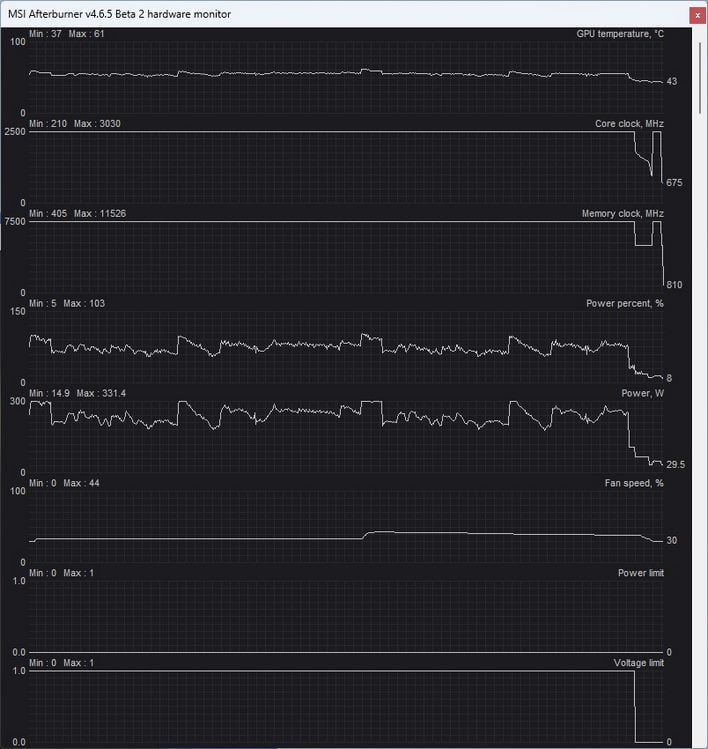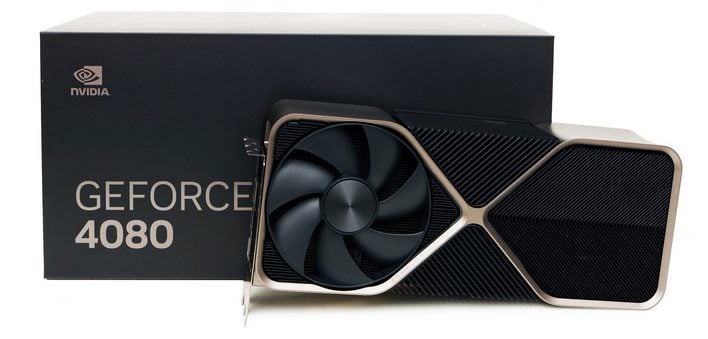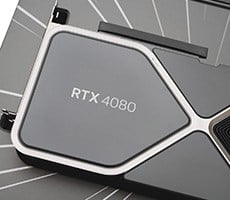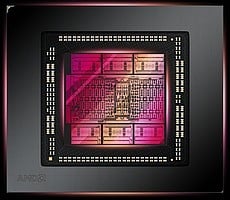NVIDIA GeForce RTX 4080 Review: Ada Lovelace For Enthusiasts
We also spent some time overclocking the MSI GeForce RTX 4080 Suprim X to see how much additional performance we could wring from its GPU and GDDR6X memory...
Overclocking The MSI GeForce RTX 4080 Suprim X
Like previous-gen GeForces, Ada Lovelace-based GeForce RTX 40 series cards feature GPU Boost, which scales frequencies and voltages, power and temperatures permitting, based on the GPU's workload at the time. Should a temperature or power limit be reached, GPU Boost will drop down to the previous boost frequency/voltage stepping, in an attempt to bring power and temperatures down gradually and not cause any significant performance swings. The maximum boost clock and power limit can be tweaked and tuned to increase performance with most cards, however.
Ada Lovelace-based GeForces like the AD103 used on the MSI GeForce RTX 4080 Suprim X will respond faster to changes in workloads versus previous-gen cards, and the cards have more robust VRMs, which should help with overclocking.
That said, like previous-gen cards, the MSI GeForce RTX 4080 Suprim X is still voltage or power limited in most circumstances to prevent damage and ensure longevity, and it's those limits that will usually be the gating factor in any overclocking. With the MSI GeForce RTX 4080 Suprim X, the power target can be increased by up to 25% and the max temperature target from 84°C to 88°C. Though the latest version of MSI's Afterburner has the option to alter voltage as well, it was greyed out with the build we used. We were still able to increase the GPU clock significantly, however.
We used the frequency offsets with the power and temperature target sliders available in Afterburner to manually push the MSI GeForce RTX 4080 Suprim X's frequencies. First, we turned up the temperature and power targets to their maximum values, and then increased the GPU and memory clock offsets until the test system was no longer stable, showed on-screen artifacts, or performance peaked due to hitting the power limit.
The MSI GeForce RTX 4080 Suprim Liquid X technically has a default boost clock of ~2,500MHz, but that number means very little in the real world, since it routinely boosted much higher (you can see it boosting over 2,800MHz while in its stock configuration above). While overclocked, we were able to take its GPU clock all the way up to an impressive 3,030MHz with a 23Gbps memory speed.
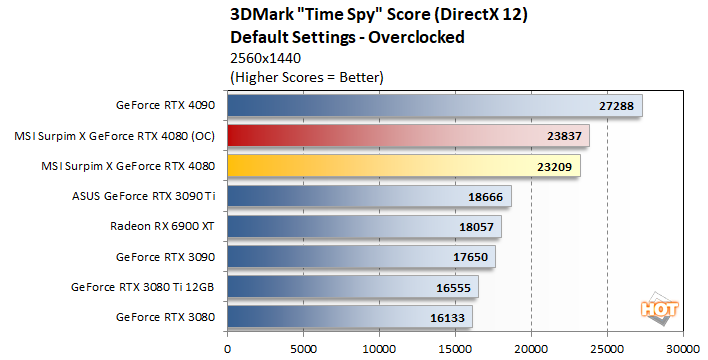
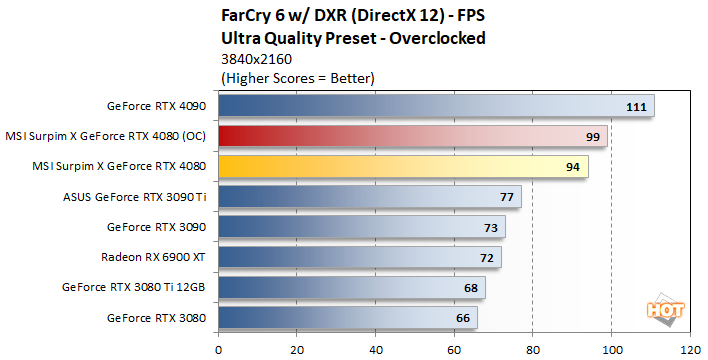
With the card overclocked, we re-ran some tests and saw some nice performance gains. 3DMark Time Spy showed a paltry 2.7% performance increase in terms of the overall score, but FarCry 6 showed larger 6.3% boost.
Total System Power Consumption
Throughout all of our benchmarking and testing, we also monitored noise output and tracked how much power the GPUs were consuming in our test system. Our goal here is to give you an idea as to how much power each GPU used while idle and also while under a heavy workload. These power numbers were captured during FarCry 6 testing, with ray-tracing enabled, and are representative of total system power consumption:
The NVIDIA GeForce RTX 4080 Founders Edition had significantly lower idle power then MSI's Suprim X, and actually consumed the least amount of power overall, at least while playing FarCry 6. Though the MSI card exhibited somewhat higher power that NVIDIA's card, it too was relatively power friendly in light of the other high end cards we tested.
Noise is not a concern with either RTX 4080 card, either. At idle or when under light loads, the MSI GeForce RTX 4080 Suprim X is effectively silent. It's fans spin down completely at idle and the card and can't be heard over typical chassis and PSU fans. When under a heavy, sustained workload, the card's fans do spin up, but it runs so cool and quiet they never produce anything more than a dull whir, though they are definitely audible and somewhat louder than expected considering the relatively low temps. The same can't be said for the NVIDIA Founders Edition, which is quieter under load. The highest GPU temperature we saw with our sample from MSI was only 61°C, which is tame in the grand scheme of things—the monstrous cooler on the MSI card, while performant, is likely overkill for the AD103.NVIDIA GeForce RTX 4080 Review Summary
Now that we’ve seen the top two Ada-based GPUs in NVIDIA GeForce RTX 40 series, we’re starting to get a clearer picture of the line-up and NVIDIA’s potential path forward. First and foremost, the GeForce RTX 4080 is a strong performer relatively to previous-gen cards. Although it has less memory bandwidth, the RTX 4080’s updated, more efficient architecture, higher clocks, and larger caches and memory capacity allowed it to clearly outperform both the GeForce RTX 3080 Ti and the previous flagship GeForce RTX 3090 Ti. There is a big performance gap between the GeForce RTX 4080 and RTX 4090, however. The smaller AD103 GPU, while fast and efficient, simply can’t hang with the beefy AD102 powering the RTX 4090.Consider the performance gap between the GeForce RTX 4080 and RTX 4090, their relatively overclockability, and the fact that both cards are powered by slightly pared down versions of their respective GPUs, and it’s obvious that NVIDIA is going to have a fair amount of flexibility to react to anything AMD or Intel do in the foreseeable future. At this moment in time, NVIDIA has the fastest, most feature rich GPUs in their stable, and the flexibility to react to competitive offering if the need arises. As much flack as NVIDIA has gotten for the RTX 40 series launch, the company seems positioned well at the moment. NVIDIA does need to decisively address the issues with the 12VHPWR connectors though, to quell any fears.
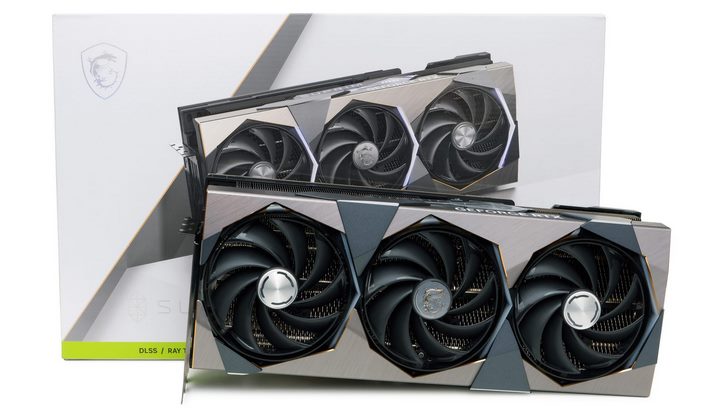
As much as we dig the high-performance nature of cards like the MSI’s GeForce RTX 4080 Suprim X, it is simply massive. The card is over a foot long and isn’t going to fit in every chassis. We suspect designing these large coolers / cards, will give board partners flexibility to introduce faster variants at some point, but we can’t help feeling that they’re somewhat over-engineered for the AD103.
In the end though, NVIDIA’s march forward means the company now has the two GPUs in its latest line-up that dominate any previous-gen offerings. With a starting price of $1,199, GeForce RTX 4080 cards aren’t cheap, but they do undercut the 3090 Ti, while offering superior performance and features. Whether the RTX 4080 remains in this price bracket for long, however, remains to be seen. AMD has stated they are targeting this performance segment with the upcoming Radeon RX 7000 series, and at lower price points. That could mean some rejiggering in a month or so, but at this point there’s nothing that can touch the GeForce RTX 4080, expect for its higher-powered sibling.


